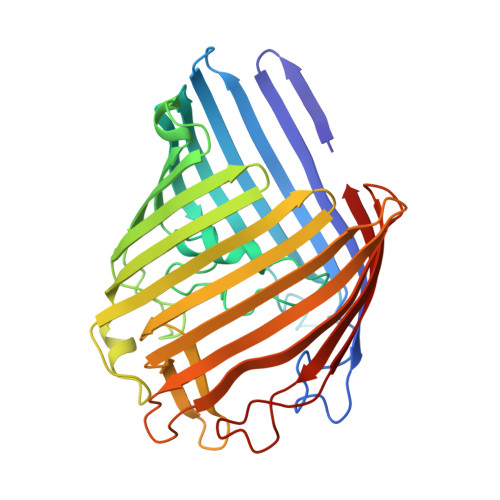Stability of trimeric OmpF porin: the contributions of the latching loop L2.
Phale, P.S., Philippsen, A., Kiefhaber, T., Koebnik, R., Phale, V.P., Schirmer, T., Rosenbusch, J.P.(1998) Biochemistry 37: 15663-15670
- PubMed: 9843370
- DOI: https://doi.org/10.1021/bi981215c
- Primary Citation of Related Structures:
1BT9 - PubMed Abstract:
The channel-forming protein OmpF porin from Escherichia coli spans the bacterial outer membrane. Each of the three monomers comprises a hollow, 16-stranded beta-barrel. These are associated to homotrimers which are unusually stable, due mostly to hydrophobic interactions between the beta-barrels. In addition, a loop, L2 connects one subunit to its neighbor by latching into its channel. Residue E71 on loop 2 is integrated into an ionic network and forms salt bridges and hydrogen bonds with R100 and R132 on the channel wall in the adjacent subunit. To examine these contributions quantitatively, six single-site, two double, and one deletion mutant were constructed on the basis of the atomic coordinates of the protein. Differential scanning calorimetric analysis showed that the salt-bridge, E71-R100, contributes significantly to trimer stability: the substitution E71Q causes a decrease of the transition temperature from 72 to 48 degreesC, with DeltaHcal diminishing from 430 to 201 kcal mol-1. A nearby substitution in the loop, D74N, has lesser effects on thermal stability, while the deletion in L2 (Delta69-77) has an effect comparable to that of E71Q. X-ray structure analysis to 3.0 A resolution revealed only local structural differences in the mutants except for the substitution R100A, where another residue, R132, is found to fill the gap left by the truncated side chain of A100. Functional assays in planar lipid bilayers show significantly increased cation selectivities if the charge distribution was affected.
- Division of Microbiology, Biozentrum, University of Basel, Switzerland.
Organizational Affiliation:
















